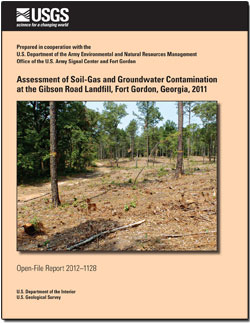Open-File Report 2012–1128
 AbstractSoil-gas and groundwater assessments were conducted at the Gibson Road landfill in 201 to provide screening-level environmental contamination data to supplement the data collected during previous environmental studies at the landfill. Passive samplers were used in both assessments to detect volatile and semivolatile organic compounds and polycyclic aromatic hydrocarbons in soil gas and groundwater. A total of 56 passive samplers were deployed in the soil in late July and early August for the soil-gas assessment. Total petroleum hydrocarbons (TPH) were detected at masses greater than the method detection level of 0.02 microgram in all samplers and masses greater than 2.0 micrograms in 13 samplers. Three samplers located between the landfill and a nearby wetland had TPH masses greater than 20 micrograms. Diesel was detected in 28 of the 56 soil-gas samplers. Undecane, tridecane, and pentadecane were detected, but undecane was the most common diesel compound with 23 detections. Only five detections exceeded a combined diesel mass of 0.10 microgram, including the highest mass of 0.27 microgram near the wetland. Toluene was detected in only five passive samplers, including masses of 0.65 microgram near the wetland and 0.85 microgram on the southwestern side of the landfill. The only other gasoline-related compound detected was octane in two samplers. Naphthalene was detected in two samplers in the gully near the landfill and two samplers along the southwestern side of the landfill, but had masses less than or equal to 0.02 microgram. Six samplers located southeast of the landfill had detections of chlorinated compounds, including one perchloroethene detections (0.04 microgram) and five chloroform detections (0.05 to0.08 microgram). Passive samplers were deployed and recovered on August 8, 2011, in nine monitoring wells along the southwestern, southeastern and northeastern sides of the landfill and down gradient from the eastern corner of the landfill. Six of the nine samplers had TPH concentrations greater than 100 micrograms per liter. TPH concentrations declined from 320 micrograms per liter in a sampler near the landfill to 18 micrograms in a sampler near the wetland. Five of the samplers had detections of one or more diesel compounds but detections of individual diesel compounds had concentrations below a method detection level of 0.01 microgram per liter. Benzene was detected in three samplers and exceeded the national primary drinking-water standard of 5 micrograms per liter set by the U.S. Environmental Protection Agency. The concentrations of benzene, and therefore BTEX, were 6.1 micrograms per liter in the sampler near the eastern corner of the landfill, 27 micrograms per liter in the sampler near the wetland, and 37 micrograms per liter in the sampler at the southern corner of the landfill. Nonfuel-related compounds were detected in the four wells that are aligned between the eastern corner of the landfill and the wetland. The sampler deployed nearest the eastern corner of the landfill had the greatest number of detected organic compounds and had the only detections of two trimethylbenzene compounds, naphthalene, 2-methyl naphthalene, and 1,4-dichlorobenzene. The two up gradient samplers had the greatest number of chlorinated compounds with five compounds each, compared to detections of four compounds and one compound in the two down gradient samplers. All four samplers had detections of 1,1-dichloroethane which ranged from 42 to 1,300 micrograms per liter. Other detections of chlorinated compounds included trichloroethene, perchloroethene, cis-1,2-dichloroethene, 1,1,1-trichloroethane and chloroform. |
First posted July 31, 2012 For additional information contact: Part or all of this report is presented in Portable Document Format (PDF); the latest version of Adobe Reader or similar software is required to view it. Download the latest version of Adobe Reader, free of charge. |
Falls, W.F., Caldwell, A.W., Guimaraes, W.G., Ratliff, W.H., Wellborn, J.B., and Landmeyer, J.E., 2012, Assessment of soil-gas and groundwater contamination at the Gibson Road landfill, Fort Gordon, Georgia, 2011: U.S. Geological Survey Open-File Report 2012–1128, 27 p., (also available at http://pubs.usgs.gov/of/2012/1128/).
Abstract
Introduction
Methods
Results
Summary
References Cited